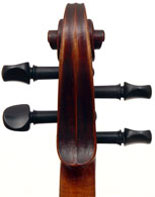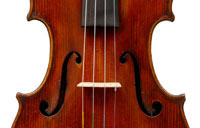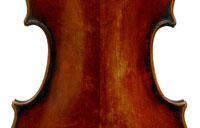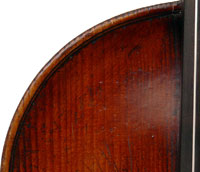Ref : 0727
An interesting violin of
Unknown Origin
Labelled 'Bottesoni'
Probably French or German, circa 1900
This violin has immediate visual appeal and tonally is rather impressive with a clean well-balanced and focused tone. It was made with attention to detail and with the liberal use of antiquing techniques intended to make the instrument look older than it is.It bears a convincing label attributing the violin to one 'Bottesoni' who claims to be a pupil of 'S. Albani', along with an impressive seal on the back, just below the button. No amount of research produced either one of the two personalities in any catalogue or book of known makers. The fact that the label is undated and doesn't give the place where the violin was made, as is normally the case, makes this almost certainly a fictitious label used generically in a line of trade instruments of a certain unknown source. In fact, an internet search will show that several persons enquired over the same label in other instruments pretty much all over the world, expressing an absence of knowledge of the source of the label. One knowledgeable commentator expressed the view that the label may have been the invention of Thibouville establishment in France. That of course if perfectly possible and would be in line with that firm's tradition of using the names of other makers under licence in its own trade instruments.
However, this violin simply doesn't look like Thibouville-Lamy's output - the workmanship is different, and the violin is artificially aged to an extent that JTL never went to. It could also be another French studio that produced it. Why French? Well, the varnish appears of a shade of red that only the French ever got right and was fond of using.
On the other hand, French lutherie dictates the use of very attractive well-figured woods in the back and sides, which this violin lacks having very plain wood in the sides, back and scroll. Furthermore, the top is of unusually wide open-grained spruce, which one would not see even in French trade violins. Aspects of this violin are consistent with German workmanship, and at a guess this violin is either German of East European (Bohemian). That it is a trade instrument from some very good studio is almost certain, because in several respects it lacks the finish and attention one would expect from a Master Luthier working in his own name.
Note that this violin is absolutely free from cracks and repairs and is in superb condition. What appears to be cracks in the photos are in fact artificial 'cracks' scratched into the violin to make it look older.
This violin would be an excellent upgrade for a highly advanced student at university level.
 |
 |
 |
||
 |
Dimensions : Back length: 36.0 cm
Condition : Excellent condition, absolutely free from cracks or discernable repairs. This violin has been artificially aged and what appears to be cracks in the photos are in fact fake 'cracks' scratched into the surface. There is some wear to one of the top's edges. Also, the top's lower treble corner is slightly damaged.
Provenance : Withheld
Price : Withheld
 |
 |
 |
 |
 |
 |
 |
 |
 |
 |
||||||
 |
 |
 |